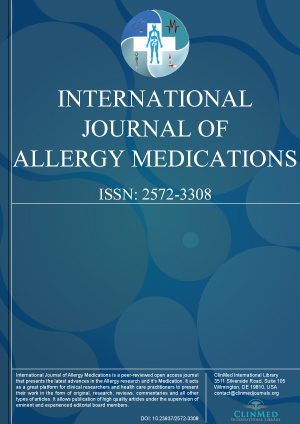Archive
Open Access DOI:10.23937/2572-3308.1510004
Soy Sauce and Allergic Skin Reaction
Keiji Sugiura
Article Type: Editorial | First Published: May 16, 2015
In this editorial, I describe the difficulties of diagnosing soy sauce allergies, since soy sauce produces histamine during brewing and storing. Some Japanese people develop irritation, itching and cellulitis after consuming foods with soy sauce. These symptoms could be caused by soy sauce allergy, histamine poisoning and/or other factors....
Article Formats
- Full Article
Open Access DOI:10.23937/2572-3308.1510003
T helper Regulation and Anti-Cytokine Therapy in Asthma
Zihan Zheng and Xinyi Huang
Article Type: Review Article | First Published: April 15, 2015
Asthma is a complex chronic inflammatory disease of the airways that is of increasing prevalence. Many different cell types are critically involved in its pathogenesis, including several classes of T helper cells. These cells may serve to generally organize the asthmatic response by virtue of the cytokines and other factors they release, which trigger downstream effects on a wide variety of cells....
Article Formats
- Full Article
Open Access DOI:10.23937/2572-3308.1510002
Hideaki Shirasaki
Article Type: Editorial | First Published: February 23, 2015
The nasal allergic response is a complex process involving the interaction of many mediators. The current therapeutic strategy is mainly based on drugs (antihistamines, nasal corticosteroids, etc.) and allergen immunotherapy. The most effective medication in persistent rhinitis is topical corticosteroid, which decreases all symptoms. Antihistamines reduce nasal itch, sneeze and rhinorrhea....
Article Formats
- Full Article
Open Access DOI:10.23937/2572-3308.1510001
The Anti-IgE Therapy: From the Known and the Unknown
Arzu Didem Yalcin
Article Type: Editorial | First Published: February 16, 2015
Asthma is described as a complex disease arising from the contribution of multiple genetic and environmental factors. Asthma is caused by multiple interacting genes, some having a protective effect and others contributing to the disease pathogenesis, with each gene having its own tendency to be influenced by the environment. At the end of 2010, 100 genes including IL-1R1,1RN, 3, 4, 5, 8RA, 9, 10, 12, 13, CTLA-4, and ADAM33, among others had been associated with asthma in six or more separate pop...
Article Formats
- Full Article

Volume 1
Issue 1
Issue 1
